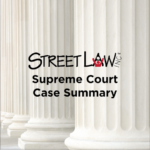In this lesson, students examine the historical context and the drafting of the First Amendment by examining the motivations of the founding generation. Students will also examine various types of “speech,” such as symbolic speech, hate speech, and political speech, to address the scope of protections promised by the First Amendment and learn that speech can only be limited when it is intended to and likely to cause imminent violence. In each instance, students will explore when the government has some authority to restrict speech; areas of consensus among scholars, judges, and citizens; the strongest constitutional arguments on each side of contested issues; and U.S. Supreme Court cases that have addressed free speech rights.
Black History Month Lesson Plans on Nonviolence
The power of nonviolent actions and attitudes as a means to resist oppression and spur reforms is a recurring feature of democratic and democratizing societies. The School Violence Prevention Demonstration Program presents educators with lesson plans that explore the use of nonviolence in history, paying particular attention to the civil rights movement and African American history. Six lessons address: the 1963 Children’s March; the concept of nonviolence using primary sources and stories of participants in the civil rights movement; the power of nonviolence; the story of Rosa Parks; citizenship schools; how music can be used to achieve social and political change.
U.S. v. Morrison (2000)
Constitutional Index – Protection from Domestic Violence Clause
The Constitutional Index breaks down the U.S. Constitution by Section, Amendment, and Clause and contains broader topics and themes. These are used to cross-reference Library resources in an effort to annotate constitutional history.
I Have a Dream: Celebrating the Vision of Martin Luther King, Jr.

EDSITEment feature highlighting resources, activities, and lesson plans to help teachers, students, parents, and caregivers understand the impact Dr. King had — and continues to have — upon our country and the global efforts towards peace and civil rights.
On the third Monday of January, Americans celebrate the life and achievement of one of our most respected citizens — Martin Luther King, Jr. Dr. King was a leading force in the drive for civil rights in the United States, and he showed through words and actions that non-violent, persistent activism can achieve tremendous results by appealing to the moral conscience of Americans.
Martin Luther King, Jr., and the Power of Nonviolence

This lesson introduces students to Martin Luther King, Jr.’s philosophy of nonviolence and the teachings of Mohandas K. Gandhi that influenced King’s views. After considering the political impact of this philosophy, students explore its relevance to personal life. (Duration: 2 class periods)
Learning Objectives:
To examine the philosophy of nonviolence developed by Martin Luther King, Jr.
To consider how this philosophy translated into practice during the Civil Rights Movement.
To explore the relationship between King’s teachings on nonviolence and those of Mohandas K. Gandhi.
To reflect on the relevance of nonviolence to one’s personal conduct in everyday life.
Martin Luther King, Jr. and Nonviolent Resistance

By examining King’s famous “Letter from a Birmingham Jail” in defense of nonviolent protest, along with two significant criticisms of his direct action campaign, this lesson will help students assess various alternatives for securing civil rights for black Americans in a self-governing society. (Duration: 3 class periods)
